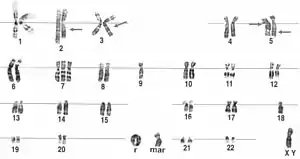Ring chromosome
A ring chromosome is an aberrant chromosome whose ends have fused together to form a ring. Ring chromosomes were first discovered by Lilian Vaughan Morgan in 1926.[1] A ring chromosome is denoted by the symbol r in human genetics and R in Drosophila genetics. Ring chromosomes may form in cells following genetic damage by mutagens like radiation, but they may also arise spontaneously during development.

Formation

In order for a chromosome to form a ring, both ends of the chromosome are usually missing, enabling the broken ends to fuse together. In rare cases, the telomeres at the ends of a chromosome fuse without any loss of genetic material, which results in a normal phenotype.[2]
Complex rearrangements, including segmental microdeletions and microduplications, have been seen in numerous ring chromosomes, providing important clues regarding the mechanisms of their formation.[3]
Small supernumary rings can also form, resulting in a partial trisomy.[4]
Ring chromosomes are unstable during cell division and can form interlocking or fused rings.[4]
Associated syndromes
Human genetic disorders can be caused by ring chromosome formation. Although ring chromosomes are very rare, they have been found in all human chromosomes. Symptoms seen in patients carrying ring chromosomes are more likely to be caused by the deletion of genes in the telomeric regions of affected chromosomes, rather than by the formation of a ring structure itself.[5] Almost all ring chromosome syndromes feature marked growth delay.[4]
Ring chromosomes can be inherited or sporadic. Mosaicism is common and affects the severity of the condition.[5] Location of fusion also affects severity due to loss of differing amounts of genetic material from the ends of chromosomes.
Disorders arising from the formation of a ring chromosome include:
| Chromosome | Typical features | |
|---|---|---|
| Ring chromosome 1 | Mental retardation, microcephaly, facial abnormalities | [6] |
| Ring chromosome 2 | Small stature | [7][8] |
| Ring chromosome 3 | [9] | |
| Ring chromosome 4 | Craniofacial abnormalities | [10] |
| Ring chromosome 5 | [11] | |
| Ring chromosome 6 | Microcephaly, facial abnormalities, hand abnormalities | [12] |
| Ring chromosome 7 | Craniofacial abnormalities, speech deficits | [13] |
| Ring chromosome 8 | Craniofacial abnormalities, hydronephrosis, hand abnormalities | [14] |
| Ring chromosome 9 | Delayed growth, abnormal facial features, low muscle tone | [15] |
| Ring chromosome 10 | Mental retardation, delayed growth, facial dysmorphia, reproductive abnormalities | [16] |
| Ring chromosome 11 | [17] | |
| Ring chromosome 12 | Delayed growth, abnormal facial features, microcephaly | [18][19] |
| Ring chromosome 13 | Microcephaly, delayed growth, reproductive abnormalities | [20] |
| Ring chromosome 14 | Epilepsy, mental retardation | [21] |
| Ring chromosome 15 | Growth delay, mental retardation, microcephaly, speech delay | [22] |
| Ring chromosome 16 | Mental retardation, microcephaly, growth delay, facial abnormalities | [23][24] |
| Ring chromosome 17 | [25] | |
| Ring chromosome 18 | Mental retardation, growth delay, facial abnormalities | [26] |
| Ring chromosome 19 | [27] | |
| Ring chromosome 20 | Epilepsy, mental retardation, abnormal facial features, growth delay | [28] |
| Ring chromosome 21 | Short stature, microcephaly, reproductive abnormalities | [29] |
| Ring chromosome 22 | Mental retardation, hypotonia, autistic-like behavior | [30] |
| Ring chromosome X | Turner syndrome | |
| Ring chromosome Y | [31] |
See also
References
- Morgan, LV (Mar 1926). "Correlation between Shape and Behavior of a Chromosome". Proceedings of the National Academy of Sciences of the United States of America. 12 (3): 180–1. doi:10.1073/pnas.12.3.180. PMC 1084483. PMID 16576974.
- Mitotic and meiotic behaviour of a naturally transmitted ring Y chromosome: reproductive risk evaluation Núria Arnedo, Carme Nogués, Mercè Bosch and Cristina Templado
- Shchelochkov O et al., Mosaicism for r(X) and der(X)del(X)(p11.23)dup(X)(p11.21p11.22) Provides Insight into the Possible Mechanism of Rearrangement, Molecular Cytogenetics 2008, 1:16
- Yip, Moh-Ying (2015). "Autosomal ring chromosomes in human genetic disorders". Translational Pediatrics. pp. 164–174. doi:10.3978/j.issn.2224-4336.2015.03.04. PMC 4729093. Missing or empty
|url=(help) - Nelson Textbook of Pediatrics, Chapter 81, 604-627 https://www.clinicalkey.com/#!/content/book/3-s2.0-B9781455775668000818?scrollTo=%23hl0003126
- "Ring chromosome 1 - Genetic and Rare Diseases Information Center (GARD) – an NCATS Program". rarediseases.info.nih.gov.
- "Orphanet: Ring chromosome 2 syndrome". www.orpha.net.
- "Ring 2" (PDF).
- "Orphanet: Ring chromosome 3 syndrome". www.orpha.net.
- "Orphanet: Ring chromosome 4 syndrome". www.orpha.net.
- "Orphanet: Ring chromosome 5 syndrome". www.orpha.net.
- "Orphanet: Ring chromosome 6 syndrome". www.orpha.net.
- "Orphanet: Ring chromosome 7 syndrome". www.orpha.net.
- "Ring chromosome 8 - Genetic and Rare Diseases Information Center (GARD) – an NCATS Program". rarediseases.info.nih.gov.
- "Ring 9" (PDF).
- "Orphanet: Ring chromosome 10 syndrome". www.orpha.net.
- "Ring chromosome 11 - Genetic and Rare Diseases Information Center (GARD) – an NCATS Program". rarediseases.info.nih.gov.
- "Orphanet: Ring chromosome 12 syndrome". www.orpha.net.
- "Ring chromosome 12 | Genetic and Rare Diseases Information Center (GARD) – an NCATS Program". rarediseases.info.nih.gov. Retrieved 2017-12-04.
- "Ring chromosome 13 | Genetic and Rare Diseases Information Center (GARD) – an NCATS Program". rarediseases.info.nih.gov. Retrieved 2017-12-04.
- "Orphanet: Ring chromosome 13 syndrome". www.orpha.net.
- "Ring 15" (PDF).
- "Orphanet: Ring chromosome 16 syndrome". www.orpha.net.
- "Ring chromosome 16 | Genetic and Rare Diseases Information Center (GARD) – an NCATS Program". rarediseases.info.nih.gov. Retrieved 2017-12-04.
- "Orphanet: Ring chromosome 17 syndrome". www.orpha.net.
- "Orphanet: Ring chromosome 18 syndrome". www.orpha.net.
- "Orphanet: Ring chromosome 19 syndrome". www.orpha.net.
- "Ring chromosome 20 | Genetic and Rare Diseases Information Center (GARD) – an NCATS Program". rarediseases.info.nih.gov. Retrieved 2017-12-04.
- "Orphanet: Ring chromosome 21 syndrome". www.orpha.net.
- "Orphanet: Ring chromosome 22 syndrome". www.orpha.net.
- "Orphanet: Ring chromosome Y syndrome". www.orpha.net.
External links
- Atlas of Genetics and Cytogenetics in Oncology and Haematology, explains HOW the ring formation causes abnormalities.